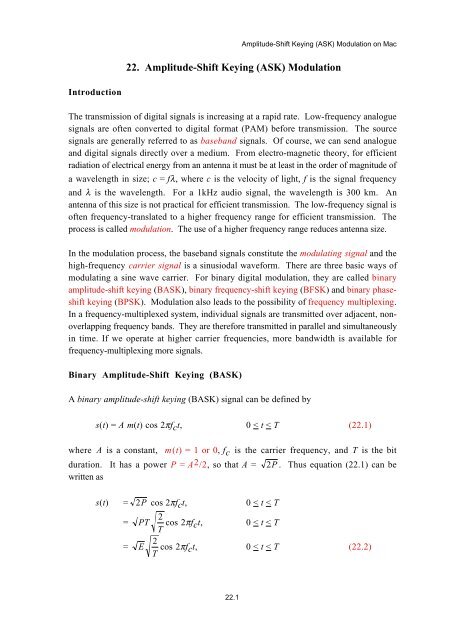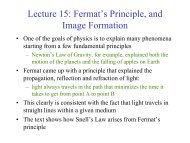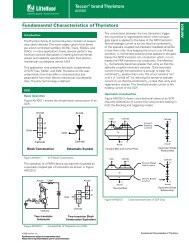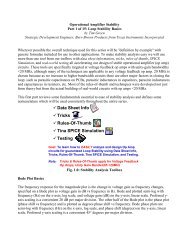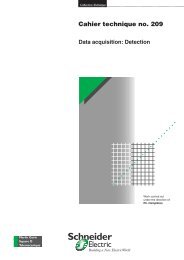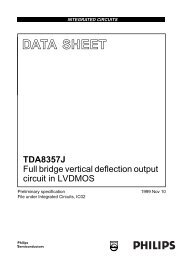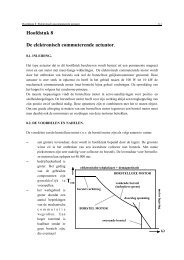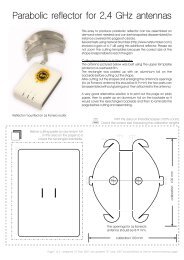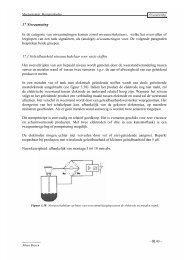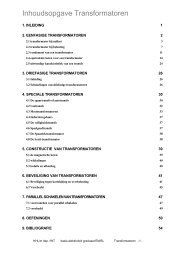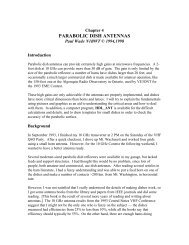22. Amplitude-Shift Keying (ASK) Modulation - Engineering
22. Amplitude-Shift Keying (ASK) Modulation - Engineering
22. Amplitude-Shift Keying (ASK) Modulation - Engineering
You also want an ePaper? Increase the reach of your titles
YUMPU automatically turns print PDFs into web optimized ePapers that Google loves.
Introduction<br />
<strong>Amplitude</strong>-<strong>Shift</strong> <strong>Keying</strong> (<strong>ASK</strong>) <strong>Modulation</strong> on Mac<br />
<strong>22.</strong> <strong>Amplitude</strong>-<strong>Shift</strong> <strong>Keying</strong> (<strong>ASK</strong>) <strong>Modulation</strong><br />
The transmission of digital signals is increasing at a rapid rate. Low-frequency analogue<br />
signals are often converted to digital format (PAM) before transmission. The source<br />
signals are generally referred to as baseband signals. Of course, we can send analogue<br />
and digital signals directly over a medium. From electro-magnetic theory, for efficient<br />
radiation of electrical energy from an antenna it must be at least in the order of magnitude of<br />
a wavelength in size; c = fλ, where c is the velocity of light, f is the signal frequency<br />
and λ is the wavelength. For a 1kHz audio signal, the wavelength is 300 km. An<br />
antenna of this size is not practical for efficient transmission. The low-frequency signal is<br />
often frequency-translated to a higher frequency range for efficient transmission. The<br />
process is called modulation. The use of a higher frequency range reduces antenna size.<br />
In the modulation process, the baseband signals constitute the modulating signal and the<br />
high-frequency carrier signal is a sinusiodal waveform. There are three basic ways of<br />
modulating a sine wave carrier. For binary digital modulation, they are called binary<br />
amplitude-shift keying (B<strong>ASK</strong>), binary frequency-shift keying (BFSK) and binary phaseshift<br />
keying (BPSK). <strong>Modulation</strong> also leads to the possibility of frequency multiplexing.<br />
In a frequency-multiplexed system, individual signals are transmitted over adjacent, nonoverlapping<br />
frequency bands. They are therefore transmitted in parallel and simultaneously<br />
in time. If we operate at higher carrier frequencies, more bandwidth is available for<br />
frequency-multiplexing more signals.<br />
Binary <strong>Amplitude</strong>-<strong>Shift</strong> <strong>Keying</strong> (B<strong>ASK</strong>)<br />
A binary amplitude-shift keying (B<strong>ASK</strong>) signal can be defined by<br />
s(t) = A m(t) cos 2πf c t, 0 < t < T (<strong>22.</strong>1)<br />
where A is a constant, m(t) = 1 or 0, fc is the carrier frequency, and T is the bit<br />
duration. It has a power P = A2 /2, so that A = 2P . Thus equation (<strong>22.</strong>1) can be<br />
written as<br />
s(t) = 2P cos 2πfct, 0 < t < T<br />
= PT<br />
2<br />
cos 2πfct, T<br />
0 < t < T<br />
= E<br />
2<br />
cos 2πfct, T<br />
0 < t < T (<strong>22.</strong>2)<br />
<strong>22.</strong>1
<strong>Amplitude</strong>-<strong>Shift</strong> <strong>Keying</strong> (<strong>ASK</strong>) <strong>Modulation</strong> on Mac<br />
where E = PT is the energy contained in a bit duration. If we take<br />
φ1 (t) = 2<br />
T cos 2πfct as the orthonormal basis function, the applicable signal space or<br />
constellation diagram of the B<strong>ASK</strong> signals is shown in Figure <strong>22.</strong>1.<br />
Figure <strong>22.</strong>1 B<strong>ASK</strong> signal constellation diagram.<br />
Figure <strong>22.</strong>2 shows the B<strong>ASK</strong> signal sequence generated by the binary sequence<br />
0 1 0 1 0 0 1. The amplitude of a carrier is switched or keyed by the binary signal m(t).<br />
This is sometimes called on-off keying (OOK).<br />
Figure <strong>22.</strong>2 (a) Binary modulating signal and (b) B<strong>ASK</strong> signal.<br />
The Fourier transform of the B<strong>ASK</strong> signal s(t) is<br />
S(f) = A<br />
∞<br />
∫ [m(t) e<br />
2 −∞<br />
j 2πfct ] e-j2πft dt +<br />
A<br />
∞<br />
2<br />
∫ [m(t) e<br />
−∞<br />
-j 2πfct ] e-j2πft dt<br />
S(f) =<br />
A<br />
2 M(f - fc ) +<br />
A<br />
2 M(f + fc ) (<strong>22.</strong>3)<br />
The effect of multiplication by the carrier signal Acos 2πf c t is simply to shift the<br />
spectrum of the modulating signal m(t) to f c . Figure <strong>22.</strong>3 shows the amplitude<br />
spectrum of the B<strong>ASK</strong> signals when m(t) is a periodic pulse train.<br />
Figure <strong>22.</strong>3 (a) Modulating signal, (b) spectrum of (a), and (c) spectrum of B<strong>ASK</strong><br />
signals.<br />
Since we define the bandwidth as the range occupied by the baseband signal m(t) from 0<br />
Hz to the first zero-crossing point, we have B Hz of bandwidth for the baseband signal<br />
and 2B Hz for the B<strong>ASK</strong> signal. Figure <strong>22.</strong>4 shows the modulator and a possible<br />
implementation of the coherent demodulator for B<strong>ASK</strong> signals.<br />
Figure <strong>22.</strong>4 (a) B<strong>ASK</strong> modulator and (b) coherent demodulator.<br />
M-ary <strong>Amplitude</strong>-<strong>Shift</strong> <strong>Keying</strong> (M-<strong>ASK</strong>)<br />
An M-ary amplitude-shift keying (M-<strong>ASK</strong>) signal can be defined by<br />
s(t) = A ⎧ i cos 2πfct, 0≤t<br />
≤T<br />
⎨<br />
⎩0,<br />
elsewhere<br />
<strong>22.</strong>2<br />
(<strong>22.</strong>4)
where<br />
<strong>Amplitude</strong>-<strong>Shift</strong> <strong>Keying</strong> (<strong>ASK</strong>) <strong>Modulation</strong> on Mac<br />
A i = A[2i - (M - 1)] (<strong>22.</strong>5)<br />
for i = 0, 1, ..., M - 1 and M > 4. Here, A is a constant, fc is the carrier frequency,<br />
and T is the symbol duration. The signal has a power Pi = Ai 2 /2, so that Ai = 2Pi .<br />
Thus equation (<strong>22.</strong>4) can be written as<br />
s(t) = 2Pi cos 2πfct, 0 < t < T<br />
= Pi T<br />
2<br />
cos 2πfct, T<br />
0 < t < T<br />
= Ei 2<br />
cos 2πfct, T<br />
0 < t < T (<strong>22.</strong>6)<br />
where E i = P i T is the energy of s(t) contained in a symbol duration for i = 0, 1, ...,<br />
M - 1. Figure <strong>22.</strong>5 shows the signal constellation diagrams of M-<strong>ASK</strong> and 4-<strong>ASK</strong><br />
signals.<br />
Figure <strong>22.</strong>5 (a) M-<strong>ASK</strong> and (b) 4-<strong>ASK</strong> signal constellation diagrams.<br />
Figure <strong>22.</strong>6 shows the 4-<strong>ASK</strong> signal sequence generated by the binary sequence<br />
00 01 10 11.<br />
Figure <strong>22.</strong>6 4-<strong>ASK</strong> modulation: (a) binary sequence, (b) 4-ary signal, and (b) 4-<strong>ASK</strong><br />
signal.<br />
Figure <strong>22.</strong>7 shows the modulator and a possible implementation of the coherent<br />
demodulator for M-<strong>ASK</strong> signals.<br />
References<br />
Figure <strong>22.</strong>7 (a) M-<strong>ASK</strong> modulator and (b) coherent demodulator.<br />
[1] M. Schwartz, Information Transmission, <strong>Modulation</strong>, and Noise, 4/e, McGraw<br />
Hill, 1990.<br />
[2] P. Z. Peebles, Jr., Digital Communication Systems, Prentice Hall, 1987.<br />
<strong>22.</strong>3
s<br />
0<br />
0<br />
s 1<br />
E<br />
<strong>Amplitude</strong>-<strong>Shift</strong> <strong>Keying</strong> (<strong>ASK</strong>) <strong>Modulation</strong> on Mac<br />
φ<br />
1<br />
( t )<br />
= 2<br />
T cos 2 π f c t<br />
Figure <strong>22.</strong>1 B<strong>ASK</strong> signal constellation diagram.<br />
Binary<br />
0 1 0 1 0 0 1<br />
sequence<br />
m(t )<br />
B<strong>ASK</strong><br />
signal<br />
A<br />
1<br />
0<br />
0<br />
-A<br />
s (t )<br />
(a)<br />
(b)<br />
T<br />
Time<br />
Time<br />
Figure <strong>22.</strong>2 (a) Binary modulating signal and (b) B<strong>ASK</strong> signal.<br />
<strong>22.</strong>4
3<br />
T<br />
m ( t )<br />
1<br />
0 1 0 1<br />
0<br />
T<br />
2T 3T<br />
(a)<br />
1<br />
2T<br />
2B<br />
1<br />
c<br />
c T<br />
-<br />
-f<br />
1<br />
c<br />
T<br />
+<br />
-f -f<br />
t<br />
3<br />
c<br />
T<br />
+ -f<br />
S ( f )<br />
<strong>Amplitude</strong>-<strong>Shift</strong> <strong>Keying</strong> (<strong>ASK</strong>) <strong>Modulation</strong> on Mac<br />
-3<br />
T<br />
Envelope<br />
-2<br />
T<br />
-1<br />
T<br />
Envelope<br />
M( f )<br />
0<br />
B =<br />
1<br />
T<br />
(b)<br />
1<br />
2T<br />
2<br />
T<br />
1<br />
2T<br />
3<br />
T<br />
0<br />
(c)<br />
...<br />
2B<br />
fc<br />
f 1<br />
c<br />
T<br />
f<br />
+ f 3<br />
c<br />
T<br />
+<br />
f 1<br />
c<br />
T<br />
-<br />
f 3<br />
c<br />
T<br />
-<br />
...<br />
Figure <strong>22.</strong>3 (a) Modulating signal, (b) spectrum of (a), and (c) spectrum of B<strong>ASK</strong><br />
signals.<br />
m (t )<br />
x<br />
Acos 2π fct 0.5 A m (t ) cos 4 π fct +<br />
0.5A<br />
m (t )<br />
s ( t ) s (t ) x<br />
f t<br />
cos 2π c<br />
(a) (b)<br />
Figure <strong>22.</strong>4 (a) B<strong>ASK</strong> modulator and (b) coherent demodulator.<br />
<strong>22.</strong>5<br />
~ 0.5A<br />
m (t )<br />
f
s<br />
... i ...<br />
0 E<br />
i<br />
(a)<br />
φ (<br />
1<br />
t )<br />
<strong>Amplitude</strong>-<strong>Shift</strong> <strong>Keying</strong> (<strong>ASK</strong>) <strong>Modulation</strong> on Mac<br />
= 2<br />
T cos 2 π f c t<br />
s 0 s 1<br />
0<br />
s 3<br />
s 2<br />
Figure <strong>22.</strong>5 (a) M-<strong>ASK</strong> and (b) 4-<strong>ASK</strong> signal constellation diagrams.<br />
Binary<br />
sequence<br />
4-ary<br />
signal<br />
4-<strong>ASK</strong><br />
signal<br />
0<br />
m (t )<br />
3<br />
1<br />
0<br />
-1<br />
-3<br />
s (t )<br />
A<br />
0<br />
-A<br />
-3 A<br />
1<br />
3 A<br />
0 0 0 1 1 0 1 1<br />
(a)<br />
(b)<br />
T T<br />
(c)<br />
(b)<br />
Time<br />
Time<br />
Time<br />
φ (<br />
1<br />
t )<br />
Figure <strong>22.</strong>6 4-<strong>ASK</strong> modulation: (a) binary sequence, (b) 4-ary signal, and (b) 4-<strong>ASK</strong><br />
signal.<br />
<strong>22.</strong>6
s (t )<br />
Binary<br />
sequence<br />
Serial<br />
to<br />
parallel<br />
converter<br />
log 2 M bits<br />
:<br />
(a)<br />
(b)<br />
<strong>Amplitude</strong>-<strong>Shift</strong> <strong>Keying</strong> (<strong>ASK</strong>) <strong>Modulation</strong> on Mac<br />
D/A<br />
converter<br />
m (t )<br />
x<br />
Acos 2π fct s (t )<br />
0.5 A m ( t ) cos 4π fct +<br />
0.5 A m( t )<br />
x ~ 0.5A<br />
m ( t )<br />
:<br />
m (t )<br />
A/D<br />
converter<br />
Binary<br />
sequence<br />
cos 2π fct Comparator<br />
Figure <strong>22.</strong>7 (a) M-<strong>ASK</strong> modulator and (b) coherent demodulator.<br />
<strong>22.</strong>7


